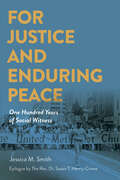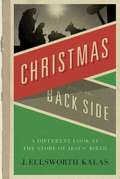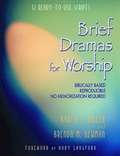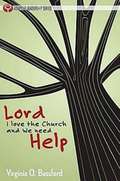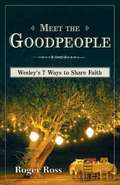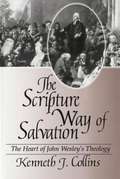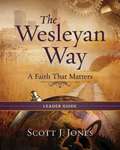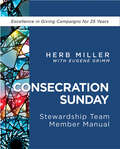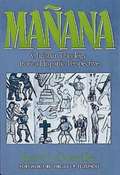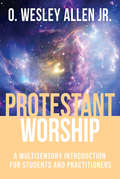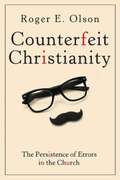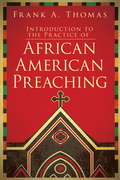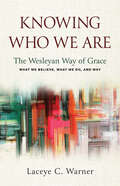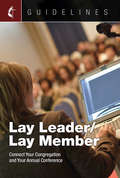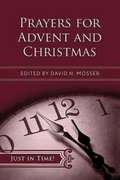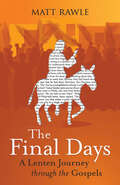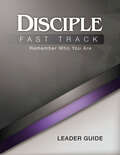- Table View
- List View
For Justice and Enduring Peace: One Hundred Years of Social Witness
by Jessica Mitchell SmithA look at the Methodist tradition of social witness.Since the beginning of the Methodist movement, “Methodists” have spoken to the issues of the day as an expression of the Wesleyan commitment to social holiness. The General Board of Church and Society upholds the Wesleyan commitment to social holiness through witnessing to just social policies and practices. This 100-year commemorative book will utilize archival materials from the agency’s historic publications to tell the story.
Christmas from the Back Side: A Different Look at the Story of Jesus Birth
by J. Ellsworth KalasCHRISTMASFROM A DIFFERENT ANGLETake a look at Christmas from alternative angles. Using an approach similar to his other “BackSide” books, Kalas crafts new insights into the scriptures of the Christmas story by looking at them from the “back side” – ...taking unique starting points...creative re-telling from different views...examining the story through new “lenses”...or looking through the eyes of a not-so-familiar character. Book session titles include: The Scandal of Christmas Three Votes for an Early Christmas Christmas Comes to a Back Fence How the Government Helped the First Christmas Happen Celebrating Christmas in a Hotel Christmas Comes to a Church Christmas and the Impossible Dream
Invitation to Genesis: A Short-Term DISCIPLE Bible Study
by Dr Peter EnnsThe Leader Guide provides process guidance for weekly group sessions. The Leader Guide understands the role of leader as facilitator of small-group sessions. Procedures for guiding sessions include: directions for using related video segments, and questions for discussion.This study takes groups into the rich tapestry of Genesis exploring the interaction between God and very human people - pride, family relationships, conflict and journey all showcase the best known stories of Creation, Noah, Abraham, Isaac, Jacob and Rebekah and Joseph.The video reflects the drama of the Genesis stories, first with selected text dramatized by an actor, and then study writer, Peter Enns interviews a scholar to help unpack the meaning and the mystery in the stories.Participants for this Invitation to Genesis do not have to have an in-depth knowledge of the Bible to enjoy and benefit from participation. Reading just two chapters of Genesis a week, they will discover the life altering stories that will invite them to follow Christ as true disciples. This eleven-week study includes a participant book outlining daily reading assignments for group preparations, a leader guide suggesting discussion activities for use in the 60–90-minute weekly meeting, and a video component providing interpretation and context for the biblical texts. Sessions: The Beginning...and What Went Wrong Another Beginning: The Flood...and What Went Wrong Another Beginning: Abraham and the Patriarchs Abraham and a Glimpse to the Future The Promise Fulfilled: Isaac Another Beginning: Jacob and the Uneasy Birth of a People Jacob: The Struggle Continues Another New Beginning: Joseph and the Family of Israel The Trek Into Egypt An End and Another Beginning: Israel's Story
Brief Dramas for Worship: 12 Ready-to-Use Scripts
by Karen F. Miller Brenda M. NewmanBrief Dramas for Worship provides dramas that are suitable for both contemporary and traditional worship services. They are appropriate for use instead of a sermon, or as the sermon. Included are questions and comments to use in a discussion following the service so that key insights from the biblical drama can be emphasized. The scripts do NOT require memorization. Each drama includes extensive "helps" which identify possible sets, simple costumes, and a detailed worship outline, including hymn and praise song suggestions, original prayers, etc. These production notes provide effective, professional presentation instructions.Permission is granted to reproduce scripts for use in congregational settings. Most of these biblically-based dramas offer a woman's point of view about a scripture story or a scripture message. Some of the "main characters" are biblical people and others are contemporary people. Dramas include: The Bethlehem Child; Margaret, a Grieving Mother Yearns for Her Wayward Son (Hosea 11:1); Bath Sheba and David; Lydia, Pilate's Wife; Martha, Prescription for Peace; Caroline: A Waitress Receives the Living Water; Eli's Wife: A Husband's Tale Brings Hope for Peace; and, Mattie May: A Mountain Woman's Tale of Gracious Plenty.
Lord, I Love the Church and We Need Help (Adaptive Leadership Series)
by Virginia O. BassfordDo we ask too much? No, we’ve asked too little. Change, chaos, confusion – how can a pastor make sense of it all? The tap root of United Methodism goes deep into fertile soil – firmly planted in Scripture and enriched by the Holy Spirit. Our theology is rich and grounded into the depths of community and accountability, but the way we live out that theology is wide and deep-- both bane and blessing. United Methodists are neither blown away like chaff nor root-bound. Our calling is still to strive to be methodically faithful and alive in Spirit. This is our heritage and our vision. But will we dare to lean into the winds of change and be strengthened by the challenges we find? Only with God's help.
Meet the Goodpeople: Wesley's 7 Ways to Share Faith
by Roger RossEver felt stuck in ways of doing church thatproduce less and less fruit each year? John Wesley sure did—until hestumbled on to seven ways to connect with non-churched people thatignited a revival. Discover how those seven methods of early Methodism,recast for the 21st century, can bring fresh faith to pre-Christianpeople and unleash a new wave of the Spirit in our day. Discussionguides in each chapter facilitate interaction for leadership teams andsmall groups, and offer practice for successful implementation.I was inspired! This is a terrific read that my leadership team will be reading together.--Adam Hamilton, Senior Pastor, The United Methodist Church of the Resurrection… helpful to pastors and laity alike!--Scott Jones, Bishop, Great Plains Conference (UMC) … Roger shares the spiritual core that leads and sustains vital, life changing ministry.-Mike Slaughter, Senior Pastor Ginghamsburg United Methodist Church…A beautifully written book…--Bill Easum, Author, Consultant, and Founder, 21st Century Strategies, Inc.… seven practices worthy of conversation, contemplation and promulgation.--Jonathan D. Keaton, Bishop, Illinois Great Rivers Conference (UMC)…helpful to Christians across the denominational landscape. Study it in groups - It will deepen your faith and help you move far beyond church walls. --Martha Grace Reese, Author of Unbinding the Gospel…Roger invites us to see, love and relate to the neighbors all around us with a new heart and new eyes.--Gregory Vaughn Palmer, Bishop, West Ohio Conference (UMC)… Roger shares how pastors and church leaders can shape the culture of their church to reach people.--Jim Griffith, Griffith Coaching
Guidelines Family Ministries: Support Families for Faith and Service
by CokesburyThe family is the primary center of faith formation, especially for children. Our affirmation for families asserts that families of all sizes and configurations are communities of commitment whose goal is human growth and faith development.You job is to work with other leaders in the congregation to plan and implement ministry in order to fulfill the church’s mission of helping all persons become disciples of Jesus Christ for the transformation of the world. Also, you address the needs of the families in your church and community so that all may grow in the Christian faith. This Guideline is designed to help equip you in leading this ministry group in your congregation.This is one of the twenty-six Guidelines for Leading Your Congregation 2017-2020 that cover church leadership areas including Church Council and Small Membership Church; the administrative areas of Finance and Trustees; and ministry areas focused on nurture, outreach, and witness including Worship, Evangelism, Stewardship, Christian Education, age-level ministries, Communications, and more.
The Scripture Way of Salvation: The Heart of John Wesley's Theology
by Kenneth J. CollinsTaking its title from one of John Wesley's most important sermons, The Scripture Way of Salvation explores the soteriological content of Wesley's entire literary corpus (sermons, letters, theological treatises, journals, and the notes on the Old and New Testaments). Fundamentally a doctrinal study, it is historically sensitive to the subtle shifts and nuances of Wesley's continuing reflections about the processes of salvation and the nature of Christian life. Collins provides a clear discussion of Wesley's emerging views about the development and maturation of Christian life, and in so doing highlights the essential structure that undergirds and provides the framework for Wesley's way of thinking about the processes of salvation.
The Wesleyan Way Leader Guide: A Faith That Matters (The Wesleyan Way)
by Scott J. JonesIn this exciting and inspiring new study, Scott J. Jones helps seekers and believers to envision and practice discipleship as a way of life. Presenting Christianity from a Wesleyan perspective, Jones invites participants into a deeper, more thoughtful, more active commitment to Christ. This Leader Guide includes everything a group leader needs to plan and facilitate the 8 sessions, helping participants to explore what they have read, to view a 12-minute video, and to discuss the reading and video with the group. The guide walks leaders through the study format and provides options for tailoring sessions to the time-frame and style of each group.
Under Wraps Devotional: The Gift We Never Expected (Under Wraps Advent series)
by Rob Renfroe Ed Robb Andy Nixon Jessica LaGroneUnder Wraps is an all-church Advent experience that explores the character of God described in the Old Testament and then revealed through Jesus Christ. Through small group resources for all ages, teaching video, worship ideas and visuals, sermon lead-in videos, and preaching guides, all areas of church life weave together for an exciting, new Advent celebration. The adult study book is the centerpiece of the program, serving as the adult small group resource and the source of content for worship planners and leaders. Each week centers on a key word that describes a characteristic of God that is evidenced in the Old Testament and then seen more clearly through Jesus: faithful, dangerous, expectant and jealous. Additional material on the theme of "Joy" is provided for an optional Christmas week focus. This companion volume that functions beautifully on its own or as part of the church-wide experience offers four weeks of daily devotions on the character of God exampled in the Old Testament and then revealed through Jesus Christ. The reflections, ideal for use during Advent, include Scripture, reflections, personal stories and insights, daily challenges, and prayers.
Consecration Sunday Stewardship Team Member Manual
by Herb MillerTeaching Stewardship from a Spiritual Perspective–Consecration Sunday Team Guide, Revised and Updated Edition.Consecration Sunday approaches financing the ministries of your congregation by teaching stewardship from a spiritual perspective rather than a fundraising perspective. It focuses on the question, "What is God calling me to do?" rather than, "What does the church need in order to pay its bills?" This revised edition offers updated language, references, and statistics while keeping everything that has resonated with the program for more than 25 years intact. Digital materials available with the Program Guide are now available via Internet download, are updated and include social media posts in additional to letters and other proven communications tools. The Consecration Sunday Stewardship Program is a proven winner; it has helped thousands of congregations increase financial giving by 15% to 30%. What do I need to get started? Order the Stewardship Program Guide (9781791024024) and gather a team. Purchase copies of the Team Member Guide (9781791024048), one for each member of your team. These resources provide complete instructions for implementing the program successfully. Also Available: Consecration Sunday Estimate of Giving Cards Pkg. of 100 (9780687064069) Living Gratitude Devotional (9781791024062) Does it work? Thousands of congregations have experienced 15% to 30% increases in financial giving with the Consecration Sunday Stewardship Program the first year plus additional significant increases in subsequent years of its use. One congregation obtained these impressive multi-year results: First year, a 14.4% increase in giving; second year, 10.3% increase; third year, 13.4% increase; fourth year, 13.6%; and fifth year, 19.6% increase. A congregation's financial secretary said, "More than two-thirds of our households made some degree of annual increase each year we used Consecration Sunday. And each year we used the program, four to six additional households decided to tithe (some of those donors grew from giving 4 percent of their income to giving 10 percent of their income)."
Mañana: Christian Theology from a Hispanic Perspective
by Justo L. GonzalezAn in-depth look at Christian theology through Hispanic eyes. It weaves the doctrinal formulations of the early church on creation, the Trinity, and Christology into contemporary theological reflection on the Hispanic struggle for liberation.This volume offers a major theological statement from a respected theologian and author. Richly insightful and unique, Manana is one of the few major theological works from a Protestant representative of the Hispanic tradition. Justo L. Gonzalez offers theological reflections based upon unique insights born of his minority status as a Hispanic American.
Protestant Worship: A Multisensory Introduction for Students and Practitioners
by O. Wesley Allen Jr.Students and leaders of worship strive to plan and lead worship well, in all sorts of circumstances. They and their fellow worshippers seek to experience a deep connection with God and with each other. In some ways, worship is about just that: connection. Protestant Worship: A Multisensory Introduction for Students and Practitioners teaches and actually demonstrates how the actions, reactions, outpourings and responses of a worship service are all part of a powerfully interwoven and ever-evolving whole. Author Wes Allen uses the analogy of physics--with its concepts of the big bang, time, space, matter, energy and chaos--to teach beginning and practicing worship leaders the fundamentals of Protestant worship. The enhanced e-book version offers photos, graphics and even videos demonstrating the book’s key content. Readers can immediately see examples of infant baptism in a contemporary service, for instance. Readers will gain understanding and build skill, to lead worship well. Many worship textbooks are written from a high liturgical perspective, weighted toward historical tradition; this approach often seems irrelevant for students and worship designers who will be planning and leading worship in the evolving twenty-first century church. Other books lean toward the most basic "how-to", emphasizing contemporary and practical aspects of worship leadership, but offering little historical or theological foundation beyond scripture. Protestant Worship provides a rich and deep foundation, and practical and immediately useful instruction.
Counterfeit Christianity: The Persistence of Errors in the Church (Counterfeit Christianity)
by Roger E. OlsonHistoric heresies didn’t die or fade away. Each generation boasts its own. Even while these counterfeit teachings remain outside the accepted bounds of Christianity, modern-day versions plague churches.So how does a church leader or pastor understand and deal with these age-old controversies when they pop up in the congregation?In this book, Roger Olson describes the curses but also gifts that heresies bring the Church. While heresies can occasionally correct a version of orthodoxy, they are not simple confusions or misunderstandings about impenetrable mysteries of divine revelation. Instead they undermine the faith and are dangerous distortions. The author describes major heresies and how the church dealt with them, the players, and what pastors can do to address these faith issues in order to educate congregations about Jesus, God, and salvation.Also included are questions for individual or group study.Also available - a Leader guide with DVD in which Adam Hamilton hosts on-screen conversations with Roger Olson (9781501806360)
Introduction to the Practice of African American Preaching
by Frank A. ThomasThe Introduction to African American Preaching is an important,groundbreaking book. This book acknowledges African American preachingas an academic discipline, and invites all students and preachers into ascholarly, dynamic, and useful exploration of the topic.AuthorFrank Thomas opens with a "bus tour" study of African Americanpreaching. He shows how African American preaching has gradually movedfrom an almost exclusively oral to an oral/written tradition. Readerswill gain insight into the history of the study of the African Americanpreaching tradition, and catch the author’s enthusiasm for it.NextThomas traces the relationship between homiletics and rhetoric inWestern preaching, demonstrating how African American preaching isinherently theological and rhetorical.He then explores thequestion, "what is black preaching?" Thomas introduces the reader tomethods of "close reading" and "ideological criticism." And thendemonstrates how to use these methods, using a sermon by Gardner CalvinTaylor as his example.The next chapter considers the question, "what is excellence in black preaching?"Thenext chapter seeks to create bridges and dialogue within the field ofhomiletics, and in particular, the Euro-American homiletic tradition.The goal of this chapter is to clearly demonstrate connections betweenthe African American preaching tradition and the field of homiletics.Thomasnext turns to questions about the relevancy of the church to theMillennial generation. Specifically, how will the African Americanchurch remain relevant to this generation, which is so deeply concernedwith social justice?
Introducción a la ética cristiana AETH: Introduction to Christian Ethics Spanish
by Ismael GarciaEl estudio de la ética no solamente nos lleva a entender mejor las complejas situaciones que hoy día enfrentamos, también nos ayuda a discernir lo que subyace tras nuestras decisiones. La ética nos ayuda a descubrir, aclarar, afirmar, cambiar, reformar o trasformar valores y fines que motiva nuestra conducta.Este libro nos proveerá con las herramientas teóricas necesarias para conocer, describir y analizar los retos ético/morales que hoy día enfrentamos los cristianos.
Knowing Who We Are: The Wesleyan Way of Grace
by Laceye C. WarnerDiscover what sets United Methodism apart. In this book, Laceye C. Warner invites you to a richer understanding of Wesleyan Christianity so you can have a clear sense of identity, better express your own beliefs, and deepen your connection with The United Methodist Church. She introduces you to important values and characteristics that make the Wesleyan way distinctive, including emphasizing God’s grace for all and sanctification as tangible transformation in your life, your community, and all creation. You’ll see how The United Methodist Church today is deeply rooted in the Christian tradition and a legacy of care, compassion, and active response to injustice in the world. And you’ll find that Christian faith in the Wesleyan tradition holds together personal faith and community life, along with a commitment to justice through ministry and service. Pick up this book and study it with your small group and discover a way of being Christian that fills you with joy, moves you to follow Jesus wholeheartedly, and spurs you to live with compassion and grace. The book can be read alone or used by small groups anytime throughout the year. Components include video teaching sessions featuring Laceye Warner and a comprehensive Leader Guide, making this perfect as a six-week group study. A companion book, Who We Are and What We Believe: 50 Questions about The UMC, is also available.
Guidelines Lay Leader/Lay Member: Connect Your Congregation and Your Annual Conference
by CokesburyThe Lay Leader and Lay Member to Annual Conference are key roles in linking the vision and plan of the congregation with the ministry of the Annual conference and in nurturing cooperation and coordination of the pastor and congregation in leadership. These two roles are complementary, yet there are responsibilities unique to each role. The greatest distinction is the connections they forge with and on behalf of the congregation. The lay leader has a primary focus in linking the local church and community. The lay member of annual conference has a primary focus in linking the local church to the connectional United Methodist Church and God's worldwide church.This is one of the twenty-six Guidelines for Leading Your Congregation 2017-2020 that cover church leadership areas including Church Council and Small Membership Church; the administrative areas of Finance and Trustees; and ministry areas focused on nurture, outreach, and witness including Worship, Evangelism, Stewardship, Christian Education, age-level ministries, Communications, and more.
The Advent Jesse Tree: Devotions for Children and Adults to Prepare for the Coming of the Christ Child at Christmas
by Dean Lambert SmithLET YOUR TREE TELL THE STORYBring Christ back to Christmas by giving your children a devotional experience that adorns your tree with Christian symbols.* The Advent Jesse Tree DEVOTIONSThis book offers 25 devotions for each day from December 1st to December 25th, Christmas Day... the day Christians celebrate that God's purpose wass finally revealed in the coming of the savior, Jesus Christ. Each devotion traces the heritage of Jesus through the stories and prophecies of the Old Testament. The Advent Jesse Tree enables individuals and families to engage in a more meaningful celebration of the Christmas season.These daily Advent devotions are written in two versions (one for children and one version for adults) including a scripture, a story & commentary, questions to ask, a prayer, and a song.* The Advent Jesse Tree ORNAMENT CRAFTSEach devotional story is paired with a representative symbol that traces the heritage of Jesus…such as a lamb, a dove, a rainbow, a heart, a star, etc. Children and their parents can utilize the symbolic line art printed with each daily devotion to craft meaningful ornaments. These symbols coincide with the prayers, a memory verses, questions for children, and songs found in the devotions for that day.Finally, on Christmas day, your tree will be filled with reminders of 25 Bible stories that led up to Christ’s birth.
Just in Time! Prayers for Advent and Christmas (Just in Time)
by David N. MosserHandy, helpful prayers to use in public worship during Advent and Christmas. The collection includes invocations, opening prayers, prayers of confession, and pastoral prayers for the Sundays of Sundays of Advent, and Christmas Eve services. Drawn from a variety of traditions, the prayers in this collection will aid any congregation as it worships throughout the journey of Advent.
The Choir Member's Companion
by Ginger G. WyrickThe Choir Member's Companion is designed for use by individual choir members in a local church adult choir. The book is intended for choir members to better understand musical symbols, terminology, and symbols used in choral music. CONTENTS: 1. Introduction to Choir Membership 2. Basic Music Reading Skills 3. Musical Road Map 4. Basic Vocal Techniques 5. Sight-reading New Music 6. How to Mark Your Music 7. Preparation for Worship 8. Preparation for Other Performances 9. Glossary of Musical Terms and Symbols
Coming Alive: Daily Meditations for Spiritual Renewal
by Steve HarperA spiritual practice for serious-minded (but busy) people.Everyone needs renewal, even the most committed among us. The spiritual life requires regular practice and a bit of time. Coming Alive: Daily Meditations for Spiritual Renewal offers five brief meditations each week for focused reading, reflection, and prayer. Each entry centers on a passage of scripture or spiritual writing. The meditations are deep, insightful, and beautifully simple, as readers have come to expect from Steve Harper’s writing. This timeless book offers a gently challenging daily habit, which leads to renewal of spirit and mind. Coming Alive features- Brief readings, about 10 minutes per day- Undated readings, so readers can determine their own pattern of practice- Spiritual depth and wisdom from ancient and contemporary sources- Foreword by Brian McLarenFrom the Foreword:“Steve Harper's new book beautifully focuses in on the real core of the spiritual life: Not dogma, not rules and regulations, not duties or guilt, not pressure or obligation ... but life, life to the full, what I like to call aliveness.”--Brian McLaren
Perfectly Flawed Women's Bible Study: God Transforms Our Weaknesses into Strengths (A Women’s Bible Study on the Life of Peter)
by Lisa ToneyWe are all flawed, but God can turn those weaknesses into strengths. The apostle Peter’s passion and imperfections make him one of the Bible’s most loved and relatable people. Even when Peter gave up, gave in, and gave out, Jesus was there for him. Join Lisa Toney as she follows Peter through his time with Jesus, from the beginning of Jesus’s ministry to the Resurrection and through Pentecost, when Peter begins to live into his call. Along the way, discover the raw honesty of a man who veered from staunch devotion to moments of doubt, mirroring our own human struggles. In the six-week Bible study Perfectly Flawed, we see that there is an unparalleled power Jesus gives that can only be found in our weakness. We discover the strength of Jesus that is available to each of us. Learn to persevere in your faith, live confidently, and boldly step into God’s purpose for you. See how Peter’s story is an invitation to embrace imperfection, find strength in the relentless grace of God, and discover how each one of us is perfectly flawed but still deeply loved by God. The participant workbook includes five daily readings for each week, combining the study of Scripture with personal reflection, application, and prayer. Other components for the Bible study include a Leader Guide and teaching video available on DVD.
The Final Days: A Lenten Journey through the Gospels
by Matt RawleThis Lent, ponder the themes of justice, poverty, freedom, and love.The four New Testament Gospels aren’t the same story, but they offer the same Resurrection hope. Matthew, Mark, Luke, and John devote most of their story detailing Jesus’ last week in Jerusalem, all highlighting Jesus’ triumphant entry into the city, the suffering and humiliation of the cross, and the empty tomb come Sunday morning, but the stories they tell aren’t quite the same. Each Gospel offers a different lens through which we understand Jesus’ Passion. One portrait reveals Jesus to be in control, while another emphasizes his suffering. In one story Jesus offers hope to the thief on the cross, and in another Jesus only receives derision. These different perspectives aren’t a reason to dismiss the Gospels; rather they reveal an abundant, diverse, and complementary picture of God’s work in the suffering, death, and resurrection of Jesus. Other components for the study include a leader guide, and teaching video are available.
Disciple Fast Track Remember Who You Are Leader Guide
by Susan Wilke Fuquay Elaine Friedrich Julia Kitchens Wilke Trust Richard B. WilkeMinimal additional preparation is needed for the Leader—just prepare handouts and follow the Leader Guide. What could be easier?This Disciple Fast Track is an adaptation of the original, bestselling Disciple Bible Study: Remember Who You Are. The study is ideal for busy people who want to fit an in-depth Bible study into their schedule. The study retains the familiar Disciple format with its theme word, theme verse, statement of the human condition, daily and weekly assignments, and prayer.This study examines the connection between memory and identity as the people of God. Participants will find common themes, including calls to remember, calls to repent, calls for renewal, and calls for community.In this study, there are 12 sessions each on the Old Testament Major and Minor Prophets (except Daniel) and on the 13 New Testament letters traditionally attributed to Paul. The prophets and Paul are continually calling hearers and readers back to their God and to a sense of who they are as a people "set apart." Daily reading assignments are designed to establish the historical context of the Prophets and of Paul. Readers will encounter "The Word of the Lord," with comments on Scripture and amplification of meaning, as well as "Marks of Obedient Community," which identifies beliefs, attitudes, and actions of the obeying community. "Marks" is the faith response to "Our Human Condition." "Marks" is the faith response to "Our Human Condition."Classes meet for a total of 24 weeks, studying the Prophets and letters traditionally attributed to Paul for 12 sessions each. Preparation is manageable, with 3–5 chapters of the Bible to read each day. Weekly sessions last 75 minutes. Hosts will provide 3-5 minute video insights related to the week's session. Flexible for use with small groups of 8–14, or for large groups of 15–100.
